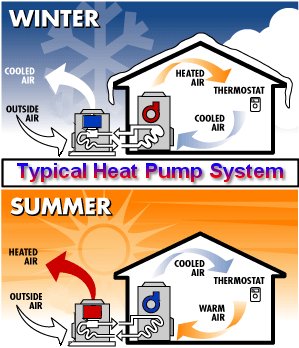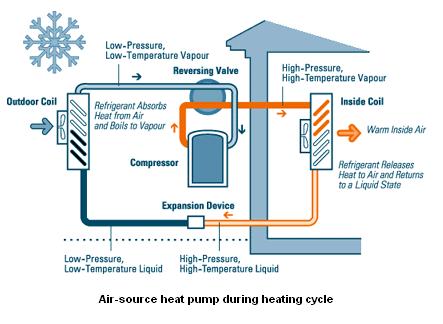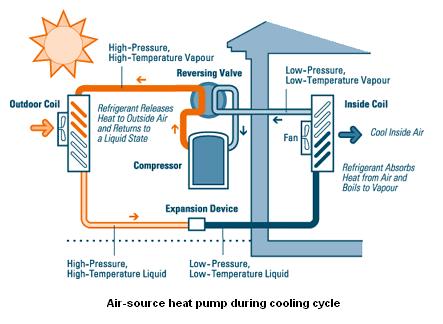|
HEAT PUMPS
| ||||||
|
|
|
|
The conventional, or most common, heat pump is an air-source heat pump. If you previously heated your home with electricity, an air-source heat pump can save 30%–40% on your heating costs. For that matter, any heat pump is generally more efficient than heating with electricity.
Heat pumps are also more effective at dehumidifying a home, than standard air conditioners, which results in less energy consumption and better cooling comfort during the summer months.
Extreme climates call for Dual-Fuel systems
As mentioned earlier a heat pump works well in moderate climates. The colder an area’s winters are, the less desirable a heat pump becomes. As outdoor temperatures plummet, a heat pump must operate longer to maintain the desired indoor temperature. At below 40* F, a heat pump must run non-stop to try to maintain set-point.
This is the point where both efficiency and comfort are compromised.

Dual-Fuel systems utilize various methods of providing emergency or auxiliary heating. These methods can be natural gas fired furnaces, propane furnaces, electric furnaces , or an air handler fitted with electric heat strips .
In most areas of the US, natural gas is much less expensive than electricity, so the gas-fired furnace is usually the natural choice for a component in a dual-fuel air-source heat pump system.
Efficiency ratings
Just like a conventional central air conditioner, a heat pump’s efficiency is rated by SEER (Seasonal Energy Efficiency Ratio). They also have an HSPF (Heating Seasonal Performance Factor) rating. These are measurements of how much heat and cooling a unit can produce from a given amount of electricity. The higher the SEER and HSPF rating, the more efficient and less costly to operate.
The unspoken truth here is that the higher the SEER and HSPF ratings, the more expensive the equipment is to install, as well. So there is a trade-off. Pay a little more now, or pay a lot more over the life of the equipment in operation costs.
In years gone by, many heat pumps were only 6 SEER. Today a heat pump can range up to about 16 SEER. The least efficient unit available for purchase today is a 10 SEER unit. Any heat pump with a SEER rating above 14 is considered a high efficiency unit.
The HSPF for the same unit ranges from 5.9 to 8.8.
The demand for higher efficiencies has driven manufacturers to improve compressors, increase heat exchanger surfaces, and improve refrigerant flow.
New developments in motors, controls and compressors are increasing efficiencies at leaps and bounds. New levels are attained each year spurned on by the competition between manufacturers.
Advanced scroll compressor design coupled with two-speed or variable speed compressors are attaining SEER ratings well above 20 SEER.
At the lower end of the range, air-source heat pumps usually have single-speed reciprocating compressors. Mid-range units usually utilize scroll or improved reciprocating compressors, with very little in the way of design differences.
Heat pumps with the higher SEER ratings and higher HSPFs invariably use variable or two-speed scroll compressors.
R22 refrigerant phase-out
The most common refrigerant used for the past 4 decades, and still the most common today, is R22, or Freon-22. R22 is a hydrochloroflourocarbon (HCFC), which is harmful to the environment.
In 2010, heat pumps or air conditioners that utilize R22 refrigerant will no longer be imported or manufactured in the US.
Read more about the R22 refrigerant phase-out
The EPA is overseeing the R22 phase-out
Other Types and Configurations of Heat Pumps
For retro-fit applications in a home without existing ductwork, air-source heat pumps called Ductless mini-splits are available. These units can be installed for as many as 4 rooms, with separate control, tied to a single outdoor unit. See our
Ductless Split page.
Geothermal ground-source or water-source heat pumps transfer heat between the ground or a water source, such as a pond. This type of system can be very costly to install, but are highly efficient. The geothermal heat pump is not hindered by colder climates due to the fact that ground or water temperatures are relatively constant. See our
Geothermal page.
Other Related Pages
Heat Pump Pros 'n' Cons: Is a HP Right for Your Home?
Ground-Source-Heat-Pumps: Mother Earth Will Wrap You In Warmth
Air Handlers fitted with Electric Heat strips
Depart Heat Pumps and Return to HOME
Please feel free to link to this page from your website. This page's URL is: http://www.perfect-home-hvac-design.com/heat-pumps.html














